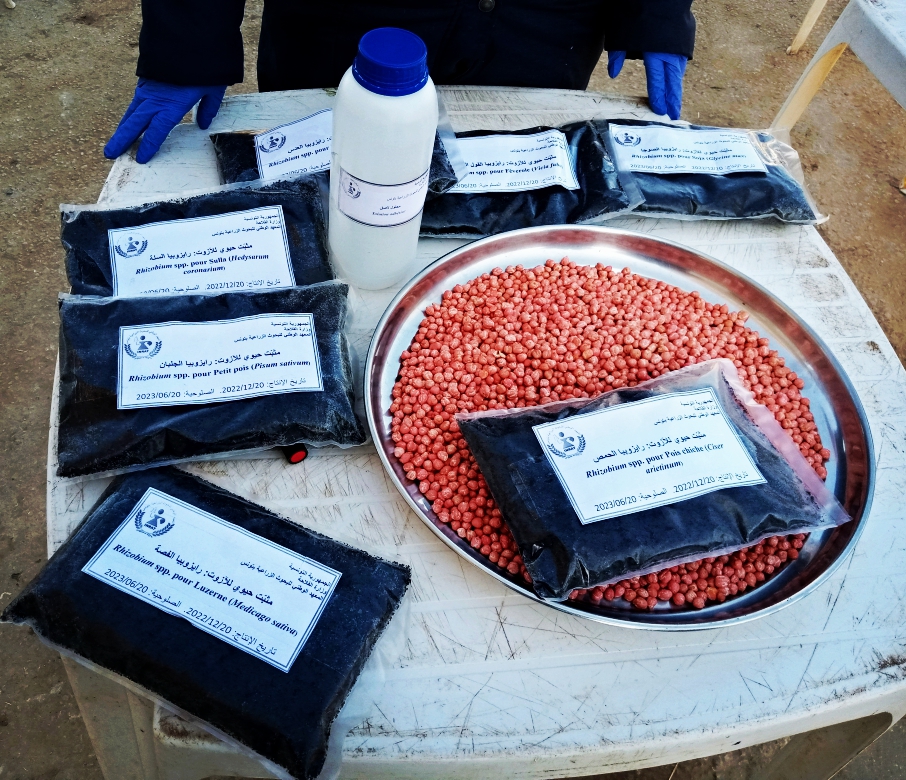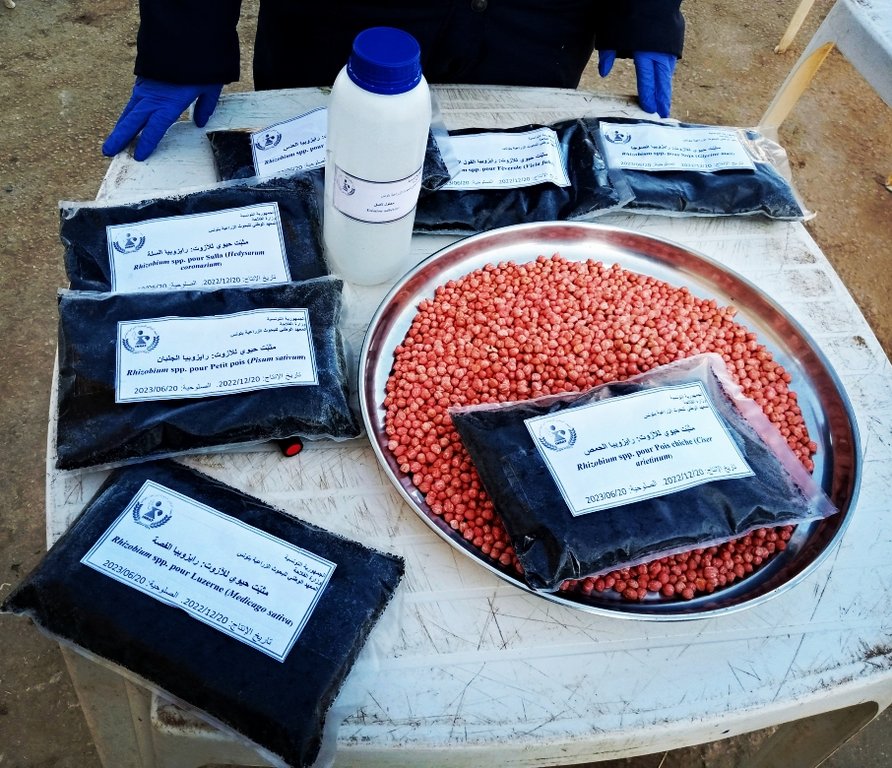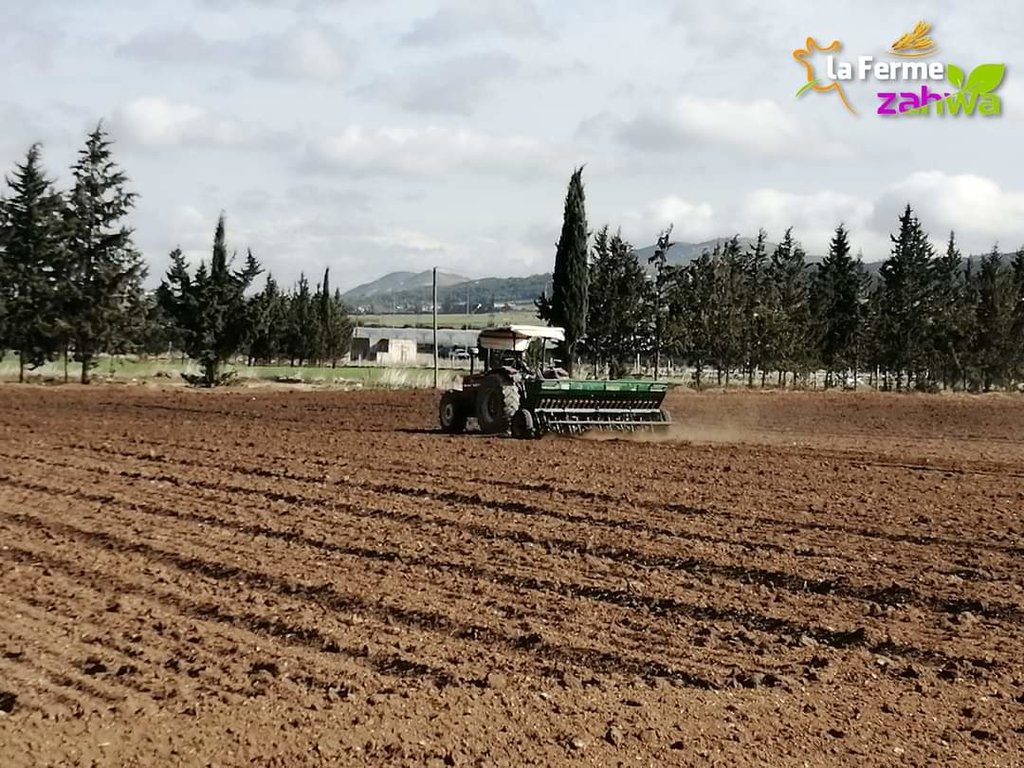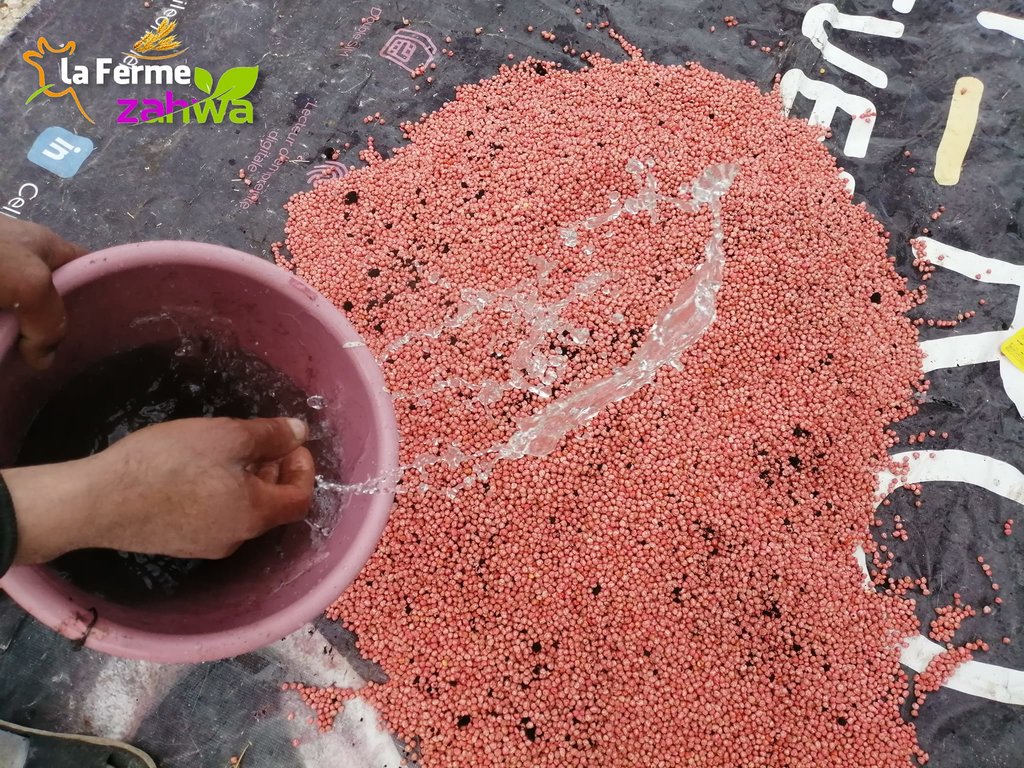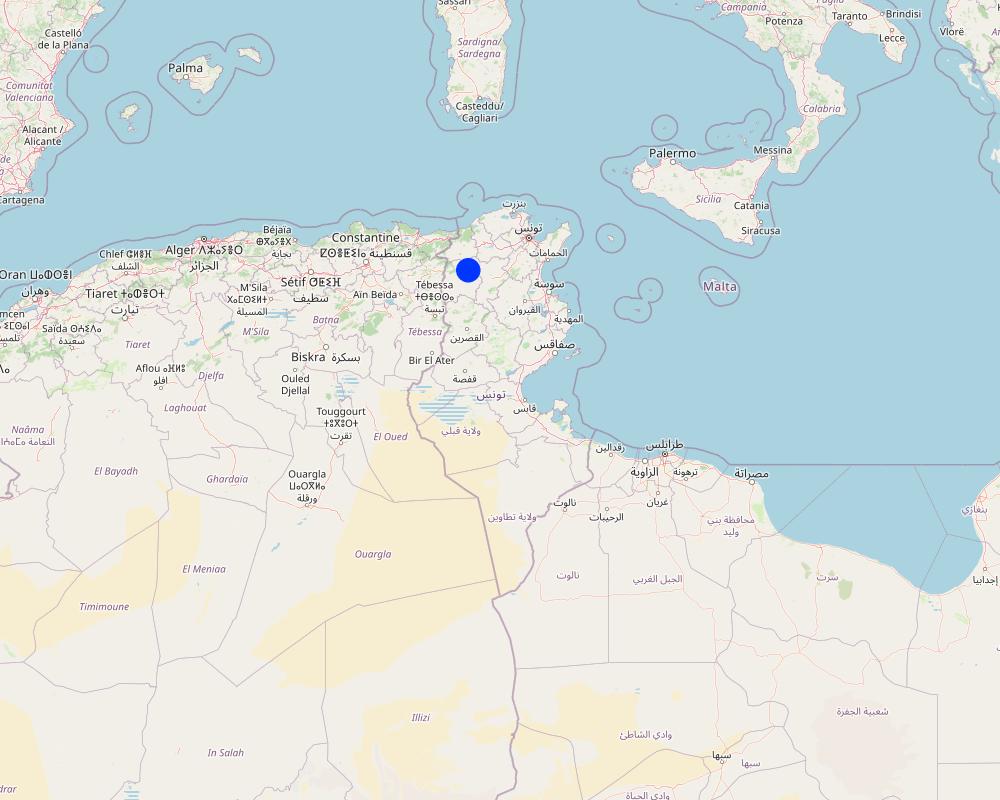Legume inoculation with Rhizobium [Tunisia]
- Creation:
- Update:
- Compiler: Wafa Saidi
- Editors: Siagbé Golli, Faouzi Harrouchi, faouzi BATTI, Fatma Maaloul, Tabitha Nekesa, Ahmadou Gaye
- Reviewers: William Critchley, Rima Mekdaschi Studer
technologies_6678 - Tunisia
View sections
Expand all Collapse all1. General information
1.2 Contact details of resource persons and institutions involved in the assessment and documentation of the Technology
Key resource person(s)
SLM specialist:
HLEL Dorsaf
National Field Crops Institute
Tunisia
SLM specialist:
HEMISSI Imen
National Agronomic Research Institute of Tunisia
Tunisia
SLM specialist:
Name of project which facilitated the documentation/ evaluation of the Technology (if relevant)
Soil protection and rehabilitation for food security (ProSo(i)l) {'additional_translations': {}, 'value': 6376, 'label': 'Name of the institution(s) which facilitated the documentation/ evaluation of the Technology (if relevant)', 'text': 'Deutsche Gesellschaft für Internationale Zusammenarbeit, Tunisia (GIZ Tunisia) - Tunisia', 'template': 'raw'} {'additional_translations': {}, 'value': 6376, 'label': 'Name of the institution(s) which facilitated the documentation/ evaluation of the Technology (if relevant)', 'text': 'Deutsche Gesellschaft für Internationale Zusammenarbeit, Tunisia (GIZ Tunisia) - Tunisia', 'template': 'raw'} {'additional_translations': {}, 'value': 6376, 'label': 'Name of the institution(s) which facilitated the documentation/ evaluation of the Technology (if relevant)', 'text': 'Deutsche Gesellschaft für Internationale Zusammenarbeit, Tunisia (GIZ Tunisia) - Tunisia', 'template': 'raw'} {'additional_translations': {}, 'value': 6376, 'label': 'Name of the institution(s) which facilitated the documentation/ evaluation of the Technology (if relevant)', 'text': 'Deutsche Gesellschaft für Internationale Zusammenarbeit, Tunisia (GIZ Tunisia) - Tunisia', 'template': 'raw'}1.3 Conditions regarding the use of data documented through WOCAT
The compiler and key resource person(s) accept the conditions regarding the use of data documented through WOCAT:
Yes
1.4 Declaration on sustainability of the described Technology
Is the Technology described here problematic with regard to land degradation, so that it cannot be declared a sustainable land management technology?
No
2. Description of the SLM Technology
2.1 Short description of the Technology
Definition of the Technology:
Low-input farming, facilitated by symbiotic microorganisms, helps sustain production while protecting the environment. In particular, inoculation with bacteria such as Rhizobium contributes to enhancing legume productivity and improving harvest quality.
2.2 Detailed description of the Technology
Description:
Rhizobial inoculum is a natural cost-effective biological product known for its enduring impact in the soil over several years. In Tunisia, Rhizobium inoculation of legumes has been used in different agro-climatic zones within sub-humid, upper semi-arid, semi-arid and upper arid climates. Most of the soils in these regions exhibit slightly alkaline pH, significant active limestone content, low levels of organic matter, and are prone to water and wind erosion due to their shallow nature.
This agricultural practice enhances the nutrient content of legumes such as beans, chickpeas, and lentils, thereby improving their growth, yield and resistance to disease and the adverse effects of climate change. It also contributes to soil fertility by stimulating the soil's microbial biomass, making it more resilient to erosion and degradation. Legumes, when integrated into cereal cropping systems, offer a unique advantage as they form symbiotic associations with soil bacteria (i.e Rhizobium).
Inoculation becomes necessary when specific indigenous bacterial populations are absent, insufficient in number or inefficient. Once the efficient Rhizobium strains required for the species to be cultivated have been isolated from the root nodules, the pure bacteria are multiplied and seeded in a sterile substrate (peat) in 400-gram bags prepared aseptically in the laboratory of the National Agronomic Research Institute of Tunisia, which is responsible for producing and marketing these biofertilizers which are then applied at the plot level, at the farmer’s premises, by coating seeds with the inoculum just before sowing, introducing Rhizobium strains into the plant-soil ecosystem. The inoculum uses an adhesive that sticks the Rhizobium to the seed and feeds it until it infects the plant. This seed coating operation is performed in a shaded area, for sowing within a few hours. Semi-sowing can be accomplished using automatic or semi-automatic seeders mixed with basic fertilizers.
Rhizobia are sensitive to various abiotic stresses, in particular drought and high temperatures, which have a negative effect on their efficiency and survival. For this reason, one or two supplementary irrigations are necessary in the absence of rain. Finally, farmers must adhere to good land management practices such as crop rotation, crop association, and rational fertilization in order to maintain the sustainability of the effect of inoculation.
The impacts of Rhizobium inoculation on legumes include the promotion of healthy and fertile soil, increased crop productivity, more resilient cropping systems in response to climate change, and sustainable cereal production, thereby ensuring food security.
Farmers across different regions have adopted the practice and are convinced by its effectiveness on their soils and crops.
2.3 Photos of the Technology
2.5 Country/ region/ locations where the Technology has been applied and which are covered by this assessment
Country:
Tunisia
Region/ State/ Province:
Sidi Bouzid
Further specification of location:
Borj El Ifa
Specify the spread of the Technology:
- applied at specific points/ concentrated on a small area
Is/are the technology site(s) located in a permanently protected area?
No
Comments:
A secured farm
Map
×2.6 Date of implementation
If precise year is not known, indicate approximate date:
- less than 10 years ago (recently)
2.7 Introduction of the Technology
Specify how the Technology was introduced:
- during experiments/ research
- through projects/ external interventions
3. Classification of the SLM Technology
3.1 Main purpose(s) of the Technology
- reduce, prevent, restore land degradation
- conserve ecosystem
- preserve/ improve biodiversity
- mitigate climate change and its impacts
- create beneficial economic impact
3.2 Current land use type(s) where the Technology is applied
Land use mixed within the same land unit:
No

Cropland
- Annual cropping
- Tree and shrub cropping
Annual cropping - Specify crops:
- cereals - barley
- cereals - maize
- fodder crops - grasses
- legumes and pulses - peas
Annual cropping system:
Fallow - maize/sorghum/millet intercropped with legume
Tree and shrub cropping - Specify crops:
- olive
- pome fruits (apples, pears, quinces, etc.)
Number of growing seasons per year:
- 1
Is intercropping practiced?
Yes
Is crop rotation practiced?
Yes

Grazing land
Extensive grazing:
- Ranching
Animal type:
- cattle - dairy
- sheep
Is integrated crop-livestock management practiced?
Yes
Products and services:
- meat
- milk
Species:
cattle - dairy
Count:
28
Species:
sheep
Count:
15

Settlements, infrastructure
- Settlements, buildings
- Energy: pipelines, power lines
3.3 Has land use changed due to the implementation of the Technology?
Has land use changed due to the implementation of the Technology?
- No (Continue with question 3.4)
3.4 Water supply
Water supply for the land on which the Technology is applied:
- mixed rainfed-irrigated
3.5 SLM group to which the Technology belongs
- rotational systems (crop rotation, fallows, shifting cultivation)
- integrated soil fertility management
- integrated pest and disease management (incl. organic agriculture)
3.6 SLM measures comprising the Technology

agronomic measures
- A2: Organic matter/ soil fertility
- A5: Seed management, improved varieties

management measures
- M2: Change of management/ intensity level
3.7 Main types of land degradation addressed by the Technology

chemical soil deterioration
- Cn: fertility decline and reduced organic matter content (not caused by erosion)
- Cp: soil pollution

physical soil deterioration
- Pc: compaction
- Pu: loss of bio-productive function due to other activities

biological degradation
- Bc: reduction of vegetation cover
- Bq: quantity/ biomass decline
- Bs: quality and species composition/ diversity decline
- Bl: loss of soil life
- Bp: increase of pests/ diseases, loss of predators
3.8 Prevention, reduction, or restoration of land degradation
Specify the goal of the Technology with regard to land degradation:
- prevent land degradation
- reduce land degradation
4. Technical specifications, implementation activities, inputs, and costs
4.1 Technical drawing of the Technology
Technical specifications (related to technical drawing):
The technical specifications include:
In the laboratory:
- isolation of bacteria based on the legume ;
- aseptic preparation of 400 g bags;
- multiplication and seeding in peat bags.
At plot level
-
-
-
Author:
Hanen Arfaoui, Amira Hachana and Imen Hemissi (INRAT)
Date:
05/2023
4.2 General information regarding the calculation of inputs and costs
Specify how costs and inputs were calculated:
- per Technology area
Indicate size and area unit:
1 ha
other/ national currency (specify):
Tunisian dinar
If relevant, indicate exchange rate from USD to local currency (e.g. 1 USD = 79.9 Brazilian Real): 1 USD =:
3.1
Indicate average wage cost of hired labour per day:
25
4.3 Establishment activities
| Activity | Timing (season) | |
|---|---|---|
| 1. | Plowing | Mid-October to early November |
| 2. | Seedbed preparation | Mid-October to early November |
| 3. | Seed preparation | December (seeding day) |
| 4. | Pre-seeding weed management (trifluralin) | December |
| 5. | Seeding | December |
| 6. | Addition of DAP fertilizer (50 Kg/ha) |
4.4 Costs and inputs needed for establishment
If you are unable to break down the costs in the table above, give an estimation of the total costs of establishing the Technology:
500.0
If land user bore less than 100% of costs, indicate who covered the remaining costs:
INGC/projet ProSol
Comments:
Under the ProSol project, seeds are provided to farmers at no cost.
4.5 Maintenance/ recurrent activities
| Activity | Timing/ frequency | |
|---|---|---|
| 1. | Irrigation after seeding ( if there is no rain or rain is delayed) | |
| 2. | Post-seeding weed management (Simazine) | Before survey |
| 3. | Fungal treatment (Anthracnose and Botrytis) | Depending on when symptoms first appear |
| 4. | Insecticide treatment (Aphids) | Depending on when symptoms first appear |
5. Natural and human environment
5.1 Climate
Annual rainfall
- < 250 mm
- 251-500 mm
- 501-750 mm
- 751-1,000 mm
- 1,001-1,500 mm
- 1,501-2,000 mm
- 2,001-3,000 mm
- 3,001-4,000 mm
- > 4,000 mm
Agro-climatic zone
- semi-arid
5.2 Topography
Slopes on average:
- flat (0-2%)
- gentle (3-5%)
- moderate (6-10%)
- rolling (11-15%)
- hilly (16-30%)
- steep (31-60%)
- very steep (>60%)
Landforms:
- plateau/plains
- ridges
- mountain slopes
- hill slopes
- footslopes
- valley floors
Altitudinal zone:
- 0-100 m a.s.l.
- 101-500 m a.s.l.
- 501-1,000 m a.s.l.
- 1,001-1,500 m a.s.l.
- 1,501-2,000 m a.s.l.
- 2,001-2,500 m a.s.l.
- 2,501-3,000 m a.s.l.
- 3,001-4,000 m a.s.l.
- > 4,000 m a.s.l.
5.3 Soils
Soil depth on average:
- very shallow (0-20 cm)
- shallow (21-50 cm)
- moderately deep (51-80 cm)
- deep (81-120 cm)
- very deep (> 120 cm)
Soil texture (topsoil):
- medium (loamy, silty)
Soil texture (> 20 cm below surface):
- medium (loamy, silty)
- fine/ heavy (clay)
Topsoil organic matter:
- high (>3%)
- medium (1-3%)
5.4 Water availability and quality
Ground water table:
on surface
Availability of surface water:
good
Water quality (untreated):
for agricultural use only (irrigation)
Water quality refers to:
surface water
Is water salinity a problem?
No
Is flooding of the area occurring?
No
5.5 Biodiversity
Species diversity:
- high
Habitat diversity:
- medium
Comments and further specifications on biodiversity:
Forage maize, cheese production, legumes, cereals, cattle breeding, arboriculture
Contractualized production (CMA)
5.6 Characteristics of land users applying the Technology
Sedentary or nomadic:
- Sedentary
Market orientation of production system:
- mixed (subsistence/ commercial)
Off-farm income:
- less than 10% of all income
Relative level of wealth:
- rich
Individuals or groups:
- individual/ household
Level of mechanization:
- mechanized/ motorized
Gender:
- women
- men
Age of land users:
- youth
- middle-aged
- elderly
5.7 Average area of land used by land users applying the Technology
- < 0.5 ha
- 0.5-1 ha
- 1-2 ha
- 2-5 ha
- 5-15 ha
- 15-50 ha
- 50-100 ha
- 100-500 ha
- 500-1,000 ha
- 1,000-10,000 ha
- > 10,000 ha
Is this considered small-, medium- or large-scale (referring to local context)?
- large-scale
5.8 Land ownership, land use rights, and water use rights
Land ownership:
- individual, titled
Land use rights:
- individual
Water use rights:
- individual
Are land use rights based on a traditional legal system?
No
5.9 Access to services and infrastructure
health:
- poor
- moderate
- good
education:
- poor
- moderate
- good
technical assistance:
- poor
- moderate
- good
employment (e.g. off-farm):
- poor
- moderate
- good
markets:
- poor
- moderate
- good
energy:
- poor
- moderate
- good
roads and transport:
- poor
- moderate
- good
drinking water and sanitation:
- poor
- moderate
- good
financial services:
- poor
- moderate
- good
6. Impacts and concluding statements
6.1 On-site impacts the Technology has shown
Socio-economic impacts
Production
crop production
Comments/ specify:
A 25-30% increase in grain yield
crop quality
Comments/ specify:
Higher seed protein content
Improved 100-grain weight
risk of production failure
Income and costs
expenses on agricultural inputs
farm income
Socio-cultural impacts
food security/ self-sufficiency
SLM/ land degradation knowledge
Comments/ specify:
Information and awareness-raising days
Ecological impacts
Soil
nutrient cycling/ recharge
soil organic matter/ below ground C
Specify assessment of on-site impacts (measurements):
The impact of this technology is assessed against a backdrop of research projects and experimental plots.
6.2 Off-site impacts the Technology has shown
Specify assessment of off-site impacts (measurements):
There is no information on off-site impacts.
6.3 Exposure and sensitivity of the Technology to gradual climate change and climate-related extremes/ disasters (as perceived by land users)
Gradual climate change
Gradual climate change
| Season | increase or decrease | How does the Technology cope with it? | |
|---|---|---|---|
| seasonal rainfall | wet/ rainy season | decrease | well |
6.4 Cost-benefit analysis
How do the benefits compare with the establishment costs (from land users’ perspective)?
Short-term returns:
very positive
Long-term returns:
very positive
How do the benefits compare with the maintenance/ recurrent costs (from land users' perspective)?
Short-term returns:
very positive
Long-term returns:
very positive
6.5 Adoption of the Technology
- 1-10%
Of all those who have adopted the Technology, how many did so spontaneously, i.e. without receiving any material incentives/ payments?
- 0-10%
6.6 Adaptation
Has the Technology been modified recently to adapt to changing conditions?
No
6.7 Strengths/ advantages/ opportunities of the Technology
| Strengths/ advantages/ opportunities in the land user’s view |
|---|
| Improved productivity |
| Reduced chemical inputs |
| Strengths/ advantages/ opportunities in the compiler’s or other key resource person’s view |
|---|
| Improves soil structure (enhances the biodiversity of degraded soil) |
| Crop biodiversity through the introduction of legumes into farming systems in areas exposed to (climatic, biotic) risks. |
6.8 Weaknesses/ disadvantages/ risks of the Technology and ways of overcoming them
| Weaknesses/ disadvantages/ risks in the land user’s view | How can they be overcome? |
|---|---|
| Access to biofertilizers | Farmer information days |
| Weaknesses/ disadvantages/ risks in the compiler’s or other key resource person’s view | How can they be overcome? |
|---|---|
| Biofertilizers are not as widely available on the market (they are still managed at an institutional level). | Introduction of biofertilizers into a large-scale production chain |
7. References and links
7.1 Methods/ sources of information
- interviews with land users
One farmer was interviewed.
- interviews with SLM specialists/ experts
Three specialists were interviewed.
- compilation from reports and other existing documentation
When were the data compiled (in the field)?
04/04/2023
7.2 References to available publications
Title, author, year, ISBN:
Effects of soil variability on the diversity of rhizobia nodulating pea (Pisum sativum L.) in Tunisia, Amira HACHANA, Imen HEMISSI, Chayma ChAMMAKHI, Amir SOUISSI, Manel BOURAOUI , Neila ABDI, Hanen ARFAOUI and Bouaziz SIFI. 2021
Available from where? Costs?
National Agronomic Research Institute of Tunisia
Title, author, year, ISBN:
Diagnostic de la diversité des souches de Rhizobium leguminosarum nodulant le pois (Pisum sativum L.) et leurs interactions avec la microflore rhizosphérique dans différentes zones bioclimatiques de la Tunisie, Amira Hachana, 2021
Available from where? Costs?
National Agronomic Research Institute of Tunisia
Title, author, year, ISBN:
Effect of Some Rhizobium Strains on Fenugreek Growth and Biological Control of Sclerotinia Stem Rot of Fenugreek Caused by Sclerotinia trifoliorum, Hemissi Imen, Hachana Amira, Arfaoui Hanen, 2021 Acta Scientific Agriculture, Vol 5(5): 37-45. ISSN: 2581-365X
Available from where? Costs?
National Agronomic Research Institute of Tunisia
Title, author, year, ISBN:
Inoculation with phosphate solubilising Mesorhizobium strains improves chickpea (Cicer aritenium L.) growth performance under phosphorus deficiency, Hemissi Imen, Abdi Neila, Bargaz Adnane, Bouraoui Manel, Yassine Mabrouk, Mouldi Saidi and SIFI Bouaziz, 2015
Available from where? Costs?
National Agronomic Research Institute of Tunisia
7.3 Links to relevant online information
Title/ description:
Fichier technique de la fixation symbiotique de l'azote Légumineuse/ Rhizobium, FAO, 1983
URL:
https://books.google.tn/books?id=Q14_9-QKkXIC&printsec=frontcover&hl=fr&source=gbs_ge_summary_r&cad=0#v=onepage&q&f=false
Title/ description:
Études écologiques et fonctionnelles de symbioses entre rhizobia et légumineuses. Thèse de doctorat, Ala Eddine Cherni, 2019
URL:
http://archive-ouverte.unige.ch/unige:120285
Title/ description:
Etude du potentiel bénéfique des souches de Rhizobium pour Medicago truncatula: symbiose, solubilisation du phosphate et lutte contre la verticilliose. Thèse de doctorat, Youssra Miloud, 2018
URL:
https://oatao.univ-toulouse.fr/24549/1/Youssra%20MILOUD.pdf
Title/ description:
Effets de la fertilisation azotée, de l‘inoculation par Rhizobium sp. et du régime des pluies sur la production de la biomasse et la teneur en azote du pois chiche, L‘taief B., Sifi B., Zaman-Allah M., Hajji M., Lachaal M., 2009, Biotechnol. Agron. Soc. Environ. 13: 537-544.
URL:
https://popups.uliege.be/1780-4507/index.php?id=4745
Title/ description:
Characterization of rhizobia nodulating chickpea in Tunisia, Mohamed Aouani, Ridha Mhamdi, Moez Jebara, Noelle Amarger, 2001
URL:
https://hal.science/hal-00886148/document
Title/ description:
Patterns for Pea Rhizobium symbiosis efficiency response to pedological and varietal variations in Tunisia, Rhizosphere, Amira Hachana, Imen Hemissi, Amir Souissi, Boulbaba L'Taief, Neila Abdi, Manel Bouraoui, Rahmah N.Al-Qthanin, Hanen Arfaoui, Bouaziz Sifi, 2O21
URL:
https://doi.org/10.1016/j.rhisph.2020.100304
Links and modules
Expand all Collapse allLinks
No links
Modules
No modules


